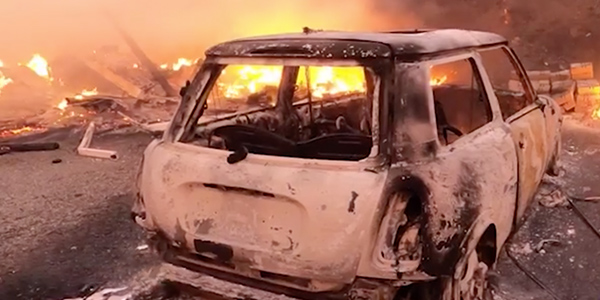Lightning started most of the major wildfires now ravaging parts of California, but the fall season, when utility equipment tends to start fires, is coming fast.
Regulators and reliability coordinators want utilities to be ready, especially with regard to public safety power shutoffs (PSPS) to prevent fires ignited by electrical equipment.
On Thursday, WECC held the third and final webinar of its August workshops on wildfires in the West. It focused on vegetation management, following earlier sessions on weather monitoring and a high-level overview of wildfire preparedness. (See WECC Tackles Wildfires as Reliability Threat.)
The week before, the California Public Utilities Commission hosted sessions to hear from the state’s three big investor-owned utilities about plans for the upcoming fire season. Commission President Marybel Batjer singled out Pacific Gas and Electric, the state’s largest utility, for the harshest criticism.
After two years of catastrophic wildfires in 2017 and 2018, PG&E blacked out 2 million people across large swaths of the state to prevent fires in 2019, while its website crashed and communication faltered. Even so, its equipment started another major blaze, the Kincade Fire in Sonoma County, state investigators determined.
Amid the COVID-19 pandemic, families are depending on electricity more than ever while working and learning from home, Batjer said. PG&E and other utilities must treat PSPS as a measure of last resort and keep them as brief and targeted as possible, making sure residents are safe and local officials are well informed, she said.
“This is what we saw PG&E unable to adequately execute on last year,” Batjer said. “PG&E’s haphazardly implemented PSPS events of last fall cannot be repeated.”
“We need to understand from PG&E, ‘Are you ready?’” she said.
Michael Lewis, interim president of PG&E, told her, “We are ready.
“It is our intent not only to meet your expectations but to exceed them this year,” Lewis said.
PG&E has been conducting PSPS drills this summer with the aim to keep the events “smaller, shorter, smarter,” he said. The utility plans to reduce customer impacts by one-third. If current measures had been in place last year, nearly 300,000 fewer customers would have been blacked out, he said.
This year, with CPUC approval, the utility placed diesel generators at numerous substations so areas of its system can “stay energized without grid support,” Lewis said. It installed 800 weather stations and 220 high-definition cameras for greater “situational awareness,” he said. And it established the goal of restoring power within 12 daylight hours — a 50% reduction from last year — after a dangerous weather system has passed, including by using equipment that can scan power lines at night for faults.
PG&E created dedicated teams to work with “critical customers” such as hospitals and COVID-19 testing centers, he said. Low-income customers who rely on medical equipment, known as medical-baseline customers, are being provided with 3,000 batteries and solar panels to charge the units, PG&E told the commission.
IOUs Outline Efforts
Southern California Edison reported similar efforts to WECC and the CPUC.
Tom Brady, senior manager of emergency response at SCE, told WECC earlier this month that the utility had installed 650 miles of insulated wire in areas at high risk of fire.
SCE also placed 1,200 fuses and remote-controlled sectionalizing devices on its system to interrupt power more quickly and prevent ignitions. Sectioning off its grid also allows SCE to limit the extent of PSPS used to keep electrical equipment from starting fires during dry, windy conditions.
“We’re able to minimalize, sectionalize and isolate the smallest footprint possible so that we’re not interrupting a lot of customers,” Brady said.
San Diego Gas & Electric, a state leader in fire prevention, told the CPUC it was using sectionalizing devices, microgrids and grid-hardening techniques, including undergrounding wires, to prevent fires. Public outreach and providing generators to medical-baseline customers and mobile home parks are part of its efforts, CEO Caroline Winn told the commission.
SDG&E has been trying to improve its prevention efforts every year since 2007, when massive wildfires swept San Diego County, she said. The IOU was the first in California to use power shutoffs as a fire-prevention tool, followed by SCE and now PG&E. The weather conditions that once only plagued Southern California have moved north in recent years.
In past years, catastrophic fires sparked by the IOUs’ equipment mainly occurred in October and November. This year will be a major test of the IOUs’ efforts to prevent destructive blazes without widespread, prolonged blackouts.
“We share the commitment of Gov. [Gavin] Newsom, of our legislative leaders and all of our CPUC commissioners to ensure that the public safety power shutoffs are conducted responsibly and only as a last resort to prevent catastrophic wildfires,” Winn said. “We’re also mindful, as you mentioned Commissioner Batjer, of the current COVID-19 pandemic and the impact of power shutoffs to our customers who are spending more and more time at home working and learning.”





